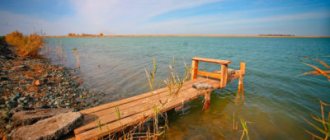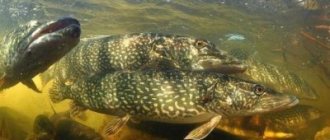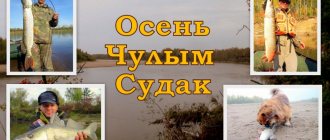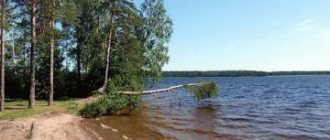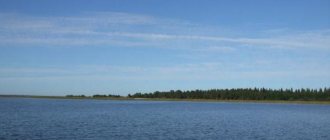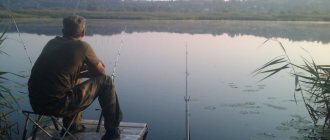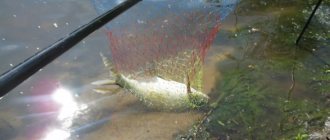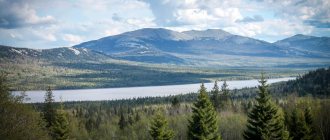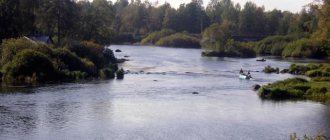Lakes of the Novosibirsk region for recreation and fishing
In summer, Lake Danilovo is always crowded. There are rumors that water from it helps with diseases of the skin and gastrointestinal tract. Vacationers collect it in bottles and take it home. Tests for the chemical composition revealed a high concentration of oxygen in the water and the absence of a standard set of minerals, apparently this explains its healing effect.
Detailed description and photo of Lake Danilovo
Marble Lake in Abrashino (Abrashinsky quarry)
Marble Lake, or Abrashinsky quarry, is a small reservoir 1.5 km from the village of Abrashino. Clean and clear water and excellent accessibility have made the lake a popular destination for summer beach holidays. People come here to swim, sunbathe, and barbecue. The depth of Marmara Lake allows diving.
Entrepreneurs quickly responded to the influx of tourists - recreation centers and recreational areas with cafes, parking lots, equipped areas for setting up tents, bathhouses, rental points for bicycles and catamarans appeared near the Abrashinsky quarry.
Detailed description and photo of Marmara Lake in Abrashino
Bear Lake
Recreation centers near Lake Medvezhye in the Novosibirsk region operate all year round. In summer, vacationers swim and cook barbecue. The beach has changing cabins, toilets, children's playgrounds, attractions, and boat rentals. The main winter entertainment is ice drifting, in which racers from different cities in Russia and abroad participate.
Fishing on Bear Lake is free. Judging by the reviews, crucian carp, grass carp, perch, and carp bite well. They say there are even crayfish. You can fish from the shore or from special bridges - they are located away from the beach.
Detailed description and photo of Medvezhye Lake
Lake Staritsa (Rybachye)
Oxbow lakes are lakes formed in the former bed of a river. There are many reservoirs with this name in the Novosibirsk region, but it was the lake near the village of Rybachye that earned the special love of the townspeople. Local residents have several other names in use: Goluboe, Lazurnoye, Konopelka.
Fans of beach holidays appreciate Lake Staritsa for its sandy shores and comfortable bottom. The pond is also popular with divers, and beginners often train here. Fishermen gather near the muddy islands. Their prey includes carp, crucian carp, bream, grass carp, and perch.
Detailed description and photo of Lake Staritsa
Ob Sea (Novosibirsk Reservoir)
An artificial reservoir on the Ob River was built in 1957–1959. Its main functions are to ensure the operation of the Novosibirsk hydroelectric power station and supply water for the needs of the city. The reservoir is not suitable for swimming; the water in it is dirty. But every summer, tent camps appear on the sandy beaches. There are especially many vacationers on the Central Beach of Academgorodok , the beaches “By the Sea of Ob , “Boomerang , “Zvezda .
Sights: Novosibirsk region, Lakes, reservoirs
Pages: 1 >
Danilovo Lake
| Location: Novosibirsk region look on the map Danilovo Lake is located on the territory of the Kyshtovsky district of the Novosibirsk region, on the very border with the Muromtsevsky district of the Omsk region, but is more popular among residents of the Omsk region than the Novosibirsk region. In the summer, many vacationers come to Danilovo, and the results of human activity are already beginning to affect the cleanliness of the lake. | |
| Read completely |
Novosibirsk Reservoir (Ob Sea)
| Location: Novosibirsk region look on the map Formed as a result of the construction of a hydroelectric power station, the Novosibirsk reservoir (often called the Ob Sea) has long become a favorite vacation spot for residents of Novosibirsk and vacationers, even from neighboring regions of Siberia, attracting with clean air, picturesque nature, beaches, and excellent fishing spots. | |
| Read completely |
Lake Gorkoe (Novoklyuchevskoe)
| Location: Novosibirsk region, Bagansky district look on the map Since 1898, Lake Gorky has been famous for its medicinal properties, the effect of which is aimed at treating the respiratory system, diseases of the musculoskeletal system, and skin. The main pride of this lake is salt, the concentration of which in the water of the reservoir is so high that even at rest an adult can easily stay afloat here. | |
| Read completely |
Lake Karachi
| Location: Novosibirsk region look on the map The lake is used as a mud and balneological resort. “Lake Karachi” is a resort of federal significance. The main natural healing properties here are sulfide-silt mud, which belongs to the category of the most therapeutically valuable mud from Russian resorts. The mineral water of the Karachi spring also has healing properties. | |
| Read completely |
Lake Tandovo
| Location: Novosibirsk region look on the map Lake Tandovo is the sixth largest lake in the Novosibirsk region, slightly elongated, it has a regular oval shape and reaches a diameter of 9 kilometers, the area of the water surface is 57 sq. km. The depth in Lake Tandov in some places reaches 2 meters, and fluctuations in water level throughout the year can reach more than 1 meter. | |
| Read completely |
Lake Tenis
| Location: Novosibirsk region look on the map Lake Tenis is difficult to access at any time of the year. It is surrounded on all sides by impassable swamps. The banks of the reservoir are flat, densely overgrown with reeds and sedges. Intensive reproduction of fish stocks is facilitated by the abundance of food in swampy reservoirs. It is home to pike, perch, and crucian carp. Therefore, Lake Tennis has rightfully acquired the status of a fishing paradise. | |
| Read completely |
Lake Chany
| Location: Novosibirsk region look on the map Lake Chany is the largest lake in Western Siberia and one of the largest lakes in the world, located in the Chanovsky district of the Novosibirsk region. Many tourists and fishermen visit these picturesque shores every year, although they have to specially introduce additional fish every year, since due to the shallow depth and other factors they regularly die out. | |
| Read completely |
Lake Yarkul
| Location: Novosibirsk region, Kupinsky district look on the map The area around Lake Yarkul is rich in a variety of birds. Here you can see a royal family of swans and pelicans scouring the surface of the reservoir in search of fish. Hunting grounds created in the vicinity of Lake Yarkul provide vacationers with the opportunity to hunt both in winter and summer. Here you can hunt roe deer, hare, elk, upland game, pheasants and some waterfowl. | |
| Read completely |
Ubinskoye Lake
| Location: Novosibirsk region look on the map Ubinskoye is the second largest lake in the Novosibirsk region after Lake Chany. Lake Ubinskoye is located in. The total length of the reservoir is 37 kilometers, width: 17 kilometers, water surface area is 436 sq. km. The depth of the lake ranges from 0.6 to 1 meter. There are several islands on the lake, according to some sources, from 5 to 7, the largest is Medyakovsky. | |
| Read completely |
Pages: 1 >
Plyushchikha River
All the rivers in Novosibirsk are distinguished by their picturesque nature. Plyushchikha was no exception. It is quite small - the length of the channel is 11 km. The river flows from northeast to southwest through the Oktyabrsky district. On the right bank there is the Gusinobrodskoe cemetery. And next to it, in a western direction, an artificial pond was created, which bears the beautiful name Forest Lake. In this area, the riverbed was widened and a beach was built, on which many different attractions were installed.
Lake Chany
The largest lake in the Novosibirsk region is Chany. Moreover, it is the largest lake in Western Siberia.
The lake is located on the territory of five districts: Zdvinsky, Barabinsky, Chanovsky, Kupinsky and Chistoozerny. It got its name from the Turkic word chan - a large vessel.
The lake is a system of reaches connected by channels and shallow areas, of which the largest are Chinyaikha, Tagano-Kazantsevsky and Yarkovsky, differing in water mineralization, area, depths, soils, and food supply.
There are recreation centers and campsites on Chany. But if you prefer a wild holiday, you can easily find a place without civilization, civil toilets and cozy beds.
Holidays on Chany will also be remembered for good fishing.
| MAP BALATSKY.RU | HOME PAGE | VIDEO LOCAL STUDIES |
NATURE OF NOVOSIBIRSK REGION
author of the video - Nikolai Balatsky
Mainland of Eurasia. The largest country on the planet, Russia, is located in the northeast of Eurasia. It occupies 12% of the world's land mass. The length of the territory of the Russian Federation from west to east is ten thousand kilometers. In the center of Russia, on its southern outskirts, is the Novosibirsk region. Its area is only one hundredth of the territory of Russia or 178 thousand square kilometers. The Novosibirsk region borders with the Omsk region in the west, with the Tomsk region in the north, with the Kemerovo region in the east, with the Altai Territory in the south, with Kazakhstan in the southwest. The maximum length of the Novosibirsk region from north to south is four hundred and forty kilometers and from west to east is six hundred and forty kilometers. The total length of the administrative border is 2700 km.
The administrative center of the Novosibirsk region is the city of Novosibirsk. It is located on the picturesque banks of the Ob and is the third city in Russia in terms of population. The territory of Novosibirsk is more than 500 square meters. km. The city is located at the junction of the forest-steppe and forest natural zones, on the Priobsky plateau adjacent to the Ob River valley. South of Novosibirsk is Akademgorodok. During its creation, a unique experiment in environmental architecture was laid out - the use of natural forests as an urban planning component. The history of domestic urban planning has not known positive examples of preserving natural forests in cities as landscaping. This is an inspiring example of the possibility of harmonious coexistence between humans and the natural ecosystem.
The Novosibirsk region is located in the southeast of the West Siberian Plain, so the surface of its territory is mostly flat. The Ob River valley divides the territory of the region into the right bank and the left bank. The left bank is a low-lying Barabinskaya plain, the average height of which is 120 meters above sea level. A characteristic feature of the plain is the ridges - elongated hills with gentle slopes. The manes stretch parallel to each other from southwest to northeast, their height ranges from two to ten meters. Griva are former watersheds of ancient rivers, formed when the glacier melted thousands of years ago. The right bank is represented by the Priobskaya foothill plain with absolute heights of 200-300 meters. The Bugotaksky hills stand out against the general background. This group of hills stretches from northeast to southwest. To the southeast of the Bugotak hills, the terrain rises noticeably and passes into the foothills of the Salair ridge. The highest point of Salair in the Novosibirsk region is Pikhtovyi Greben. From a height of half a kilometer above sea level, a wonderful panorama of the surrounding area opens up.
CLIMATE
The Novosibirsk region is located far from the seas and oceans, so the climate here is continental. Winter is harsh and long with stable snow cover, strong winds and snowstorms. Snow cover lasts from 5 months in the south to 6 months in the north. Summer is hot and relatively short - from 3 months in the north to 4 months in the south. In June-July, a large number of mosquitoes, midges, and horse flies appear. Spring is relatively short, bright, but with returns of cold weather and probable snow cover in May. Autumn is longer, with alternating frosts already in August and summer-like warm days in September-October. With the onset of warmth after the first autumn frost, some plants bloom again. In the last 15-20 years, alternating waves of heat and cold have become typical for the Siberian climate. In November, permanent snow cover sets in. The average air temperature in January is minus 15-20°, and in July – plus 18-21° Celsius. Over a hundred-year period, the average annual temperature rose to +3° Celsius. The average annual precipitation is more than 400 mm, of which 70% of precipitation falls in the form of rain, but in the southern steppe regions precipitation falls significantly less.
RIVERS AND LAKES
The Novosibirsk region is rich in water. More than 7,000 rivers have laid their channels across its territory, including the smallest rivers with a channel length of less than ten kilometers. This map shows 430 rivers with a channel length of more than ten kilometers. All rivers belong to three basins: the closed drainage basin, the Irtysh basin, and the Ob basin.
Many rivers of the region carry their waters into the Ob basin, of which the main right tributary is the Inya River. The total length of the Ini River is about 560 km, of which 260 km before it flows into the Ob it flows through the Novosibirsk region. The main river is Ob. Within the region, the length of its channel is 330 km. In 1956, south of the city of Novosibirsk, the Ob was blocked by a hydroelectric dam. The height of the dam was 33 meters. This is how the Novosibirsk Reservoir appeared - the largest artificial reservoir in Western Siberia (reservoir length 150-180 km, area - 1070 sq. km, water volume - 9 cubic km). 30 small rivers flow into the reservoir. The main water artery of the reservoir is the Berd River, which originates in the Salair Mountains. In its upper reaches, the Berd is characterized as a typical mountain river. But when it reaches the plain, its flow slows down, and the mouth part is the vast Berdsky Bay.
There are 85 rivers in the Irtysh basin. The most abundant among them is the Om River, which originates from the Vasyugan swampy plain. In a closed drainage basin, rivers flow into closed lakes. Thus, the Karasuk River slowly carries its waters along the south of the region for more than 500 kilometers and forms an extensive network of channels and dams. The river bed is overgrown with reeds.
On the territory of the Novosibirsk region there are more than 2,500 fresh, salt and bitter-salt lakes. The largest lakes are located in the center and southwest of the region. These are Chany (1,500 sq. km), Sartlan (238 sq. km), Ubinskoe (440 sq. km). In photographs from space, the Chany Lake system is Bolshie Chany, the largest lake in Western Siberia, to the south is Malye Chany and to the west is the drying up Yudinsky Reach. The water area of Bolshie Chany has a complex configuration with many islands, which are half-submerged manes.
The relatively small lake Karachinskoye is well known in the region. The lake is an endorheic salt lake, its length is about 2.5 km, and its width is less than 1.5 km. The depth of the reservoir is variable and depends on precipitation, spring floods, air temperature and the amount of water in the nearby fresh lakes Uzunkul, Maly and Bolshoy Yarkul, which are in a hydrological relationship with Lake Karachinsky.
A fifth of the territory of the region is occupied by lowland, transitional and raised bogs. The largest tracts of swamps are located in the north of the region, where the Vasyugan swamp system reaches its southern edge.
FLORA
Due to its geographical location and climatic conditions, the region has a latitudinal zonality in the form of three natural zones of vegetation cover with more than 1,350 species of higher vascular plants. These are forest, forest-steppe and steppe zones.
In the north of the region, significant areas are occupied by forest in the Vasyugan forest-swamp massif. The forest area here makes up 24% of the total area of the region, of which less than 30% is coniferous forests and more than 70% is deciduous forests.
The Vasyugan raised bogs, which are also called sphagnum bogs, are widespread in these places. In raised bogs, the tree layer is practically absent. The herb-shrub layer consists of dwarf birch, marsh wild rosemary, cotton grass, and sundews. Various types of lichens, including moss moss, are widespread here. In autumn, nature generously shares with the inhabitants of these places the ripening berries of lingonberries, blueberries, cloudberries, crowberries and, of course, cranberries and various mushrooms.
Raised bogs are formed due to heavy precipitation and its accumulator - greenish-white moss - sphagnum. In an air-dry state, sphagnum mosses are able to absorb water approximately 20 times their own weight, which is 4 times greater than the capabilities of absorbent cotton wool. Among the Vasyugan peat bogs there are numerous round lakes that resemble huge bowls of water. Instead of a shore, such lakes have a raft, which is a floating carpet of wetland plants with powerful rhizomes. Sphagnum bogs maintain the hydrological regime of the surrounding areas; many of our northern rivers originate from them. Among them is the Tara River. This is evidenced by the brown color of its water.
To the south, coniferous trees are replaced by birch and aspen. To the south stretch flat forest-steppes. Basically, this is the Barabinskaya forest-steppe, where open spaces alternate with islands of light birch and aspen forests - kolki. Forest islands may be small, but they also contain shade-loving forest plants. On the outskirts of the ridges in the spring and summer, plants of various habitats are found. Here you can see helmeted orchis, buttercups, and horsetails. In early spring they bloom: broad-flowered lumbago, soft lungwort, hairy violet, Siberian adonis, long-stemmed primrose. Later, many plants bloom, including forest anemone, common popovnik, Asian swimmer, Russian iris, marsh forget-me-not, meadow geranium, common chicory, bellflower, Siberian skerda, saranka lily and others.
In the Ob basin there are larger tracts of small-leaved forests with the inclusion of coniferous trees. Various types of ferns, horsetails, umbrella plants and wild strawberries are noticeable in the herbaceous layer. In the light pine forests there is an undergrowth of common bird cherry, blood-red hawthorn, caragana, common viburnum, Siberian mountain ash, common raspberry and thorny rosehip thickets. On the edges of the forest, warmed by sunlight, the narrow-leaved chamerion, also known as fireweed, fascinates with its bright blooms.
Along the Ob riverbed and in the steppe zone, on sandy soils, ribbon forests grow in the form of very long strips of ribbons, stretching from northeast to southwest and separated by vast steppe spaces.
The vegetation in the floodplains of reservoirs is no less diverse. The river banks are overgrown with tree willow, bird cherry, currants, and blackberries. Umbrella susak grows in shallow waters. Its pale pink flowers, collected in an umbrella, are clearly visible in the middle of the Siberian summer. Arrowhead and marsh marigold grow along the marshy banks. In the open water of river backwaters, the common waterweed, the yellow egg capsule and its relative, the small egg capsule, bloom. The white lily is much less common. In reservoirs well warmed by the July sun, you can see a continuous carpet of small duckweed and floating salvinia.
The banks and shallow waters of fresh steppe reservoirs are quite densely overgrown with cattails and reeds, which are much taller than human height.
In the southwest of the Novosibirsk region, the Barabinskaya lowland turns into the treeless Kulundinskaya steppe plain. Due to harsh climatic conditions and constant winds, tree and shrub vegetation is practically absent, and herbaceous vegetation acquires pronounced steppe features. The forbs are relatively rich in species composition, but they are dominated by various species from the Poaceae, Compositae, Chenopoaceae, and Legume families. Along the shores or in places of dried up salt lakes there are waterlogged salty soils - salt marshes, on which a complex of salt-tolerant plant species grows. The most prominent species here is the European saltwort. In autumn, the salt marshes turn from green to burgundy, and the vast expanses of salt marshes from a distance resemble a Martian landscape.
More than 300 plant species are found on the Bugotaksky hills. The narrow border between the southern and northern slopes of the hill separates light-loving and steppe plants from forest and moisture-loving ones. In the shade of the birches grow Siberian skerda and medicinal burnet, and in the shade of the hill - bearded gentian, dye's navel, Alpine aster, purple sedum, mountain clover, and spiny rose hips. On the southern slopes of the hills there are three types of feather grass, a slime onion with an original multi-flowered umbrella and many other plants. A typical plant of the southern slopes is the spiny mountain grate. This phenomenally hardy biennial can withstand summer temperatures up to plus 60°C and winter freezing down to minus 50°C. Despite the frost, the leaves of the cabbage, covering the flower bud, remain green until spring. In the second year of life, the prickly head throws out the original columnar peduncle and then dies, leaving numerous seeds for procreation...
Salair Ridge. In the Western spurs of Salair, various types of forest occupy large areas. Most often these forests are a mixture of fir, aspen, birch and pine with dense undergrowth. In some places, certain tree species predominate. But there are also pine forests and aspen forests. The main attraction of Salair are the pure fir trees. The most characteristic type of forest on Salair is aspen-fir forests or black taiga. On a hot summer day in such a forest there is twilight, you feel cool and damp. In the summer-autumn period it often rains, after which everything is saturated with moisture.
The forests of Salair are beautiful in their own way at any time of the year. In winter there is a lot of snow. The snow cover on Salair is the deepest in the region. In the spring, on the first thawed patches of slopes and forest glades, Siberian primroses bloom together - Siberian candyk, yellow corydalis, Altai anemone, Fedchenko's gooseberry, Pallas's primrose, hairy violet, Siberian adonis, broad-flowered lumbago.
FAUNA
Due to the geographical location of the region, three natural zones, abundance of water sources, diverse landscapes and the growth of many plant species, the fauna of the region in the spring-summer period is especially rich and diverse. The leaders are invertebrate animals, of which there are more than 10,000 species in the region! The most noticeable of them are arthropods. These include crustaceans, centipedes, arachnids and insects - beetles, butterflies, hymenoptera, diptera, dragonflies, orthoptera...
Among crustaceans, the narrow-clawed crayfish is the largest in size. It lives in clean fresh waters of the region. Cancer is colored from dark green to dark ash color. Near springs where the soil contains blue clay, crayfish of a pale blue color are found.
The small crustacean Artemia inhabits the bitterly salty lakes of Baraba. Reaches a length of 8-12 mm. The number of brine shrimp in Lake Karachinskoe is more than four billion specimens!
In damp places, a terrestrial representative of crustaceans is found - the rough woodlice.
Among arachnid animals, there are various types of ticks, including the pasture tick in the forest-steppe and the taiga tick in the forest zone. These mites wait and attack warm-blooded animals from plants and feed on their blood.
A large spider lives in forest copses - the common cross spider. It weaves large webs of spider webs to catch insects. Sometimes the prey turns out to be larger than the hunter himself...
The silverback spider spends most of its life in water. Underwater, he builds “castles in the air” from spider webs for resting and eating.
Among spiders, the South Russian tarantula is the leader in size. It feeds on small arthropods. The spider stays either at the entrance to the hole, or slightly leaning out. Aggressive disposition. Stands up, lunges towards moving objects, and can also jump. In spring, the female weaves a cocoon with laid eggs and guards it without feeding. The spiderlings first stick to the female’s body, and then begin to crawl away. Later the female weakens and dies.
The steppe zone is home to a spectacular spider, Argiope Brünnich, whose abdomen is shaped and colored like a wasp. Females, like other spiders, are larger than males. Mating occurs immediately after molting, which precedes the maturation of the female, while the covers of her chelicerae remain soft. After mating, the female eats the male and inseparably protects her future offspring, enclosed in this light cocoon.
Of the millipedes, there is a mobile mite-bearing drupe up to 3 cm in length. Another representative of centipedes, the spotted nodule, reaches 1.5 cm in length and has more than 200 legs.
The insect fauna is the most diverse. Coleoptera or beetles are the most numerous species in nature. Among them are the Colorado potato beetle and the aspen leaf beetle, the wax beetle and the nimble water-dwelling beetles. Sparkling in the sun, they catch small invertebrate animals on the water surface. The decorated T-shirt is a poisonous and very unusual beetle. Mikey larvae parasitize the nests of bees and other insects, feeding on their eggs. The active larva, triungulina, attaches itself to a bee from a flower and enters its nest.
Lepidoptera or butterflies are in second place in the number of species in nature. Among them are brightly colored diurnal butterflies: meadowsweet, wren, gypsy moth and various types of bluebirds. In mid-summer, hawthorns and the largest, most beautiful and rare butterfly in the region, the Apollo, fly out en masse. This butterfly is listed in the Red Books of Russia and the Novosibirsk region.
In its development, any butterfly goes through the stage of a growing caterpillar. The caterpillar grows and turns into a sedentary pupa, from which a bright butterfly then emerges.
Hymenoptera insects are in third place in the number of species in nature. These are bees, wasps, bumblebees, ants and others. Red forest ants live in large families underground, and build a summer home above the ground - an anthill.
Our dragonflies are associated with water bodies, and their predator larvae develop in water.
Among vertebrate animals, more than 350 species of birds, 80 species of mammals, 33 species of fish, 6 species of reptiles and 7 species of amphibians are found in the region.
The rivers and lakes of the Novosibirsk region are home to 33 species of bony fish and 2 species of lampreys. Among them are common pike, crucian carp, tench, river perch, common ruffe, spotted sculpin, sleeper sleeper, burbot, bream, pike perch, taimen, lenok, grayling, Siberian sterlet, Siberian sturgeon and, outwardly similar to fish, - lamprey.
In April, amphibians wake up. Among them, the Siberian salamander emerges from its winter shelters the earliest. Then frogs and other amphibians. After a long and prolonged winter hibernation, amphibians are found in water bodies. Males display mating, mating and laying eggs. From the eggs, larvae emerge, which develop in the water for two months, feeding on algae and small invertebrates, and then come ashore. Young frogs and toads are only slightly larger than mosquitoes.
The common newt lives in low-flow or stagnant bodies of water all summer. Here he feels like a fish in water. And the Siberian salamander, having laid its eggs in the water, spends the summer on the ground, hiding from sunlight in damp, secluded places.
The Novosibirsk region is inhabited by the gray toad and the rarer green toad. Most often you can see the modestly colored sharp-faced frog in the region. But much less common is the Siberian frog, which has a bright appearance. The lake frog is the largest among amphibians. It lives only in the southeastern regions of the region. It lives mainly in water and does not move far from the reservoir. In the month of May, the chorus of lake frogs can be heard quite far away.
Reptiles or reptiles are rarely seen. The sandy lizard lives in open forest-steppe spaces. Females and young sand lizards are colored brown, and males acquire a bright green body color with age. A viviparous lizard lives in the forest zone. She gives birth to these miniature cubs. The poisonous snake is an ordinary viper, widespread everywhere, but it always avoids meeting people. In the forest zone and along the banks of reservoirs you can find a non-venomous snake - the common grass snake. A rare poisonous snake lives in the Salair region - the common copperhead.
The region is home to 80 species of mammals. Of the insectivorous animals, the common hedgehog is found in the forest zone, and the long-eared hedgehog is found in the steppe. There are 11 species of bats known in the Salair region. They winter in underground caves, gathering in small groups in crevices and niches of stone walls. Lots of rodents. These include the red-cheeked ground squirrel and the Barabinsky hamster in the steppe, the marmot in the forest-steppe, the Siberian chipmunk in the forest zone, and the largest of the rodents, the river beaver.
A cautious badger lives in the vast expanses of the Novosibirsk region, usually leaving its deep hole at night in search of food. There are still many roe deer, mostly associated with reserves where hunting is prohibited. In the region you can see moose, and in winter, gray wolves, hunting in groups in search of prey. The lynx lives in the Salair forests. In winter, she has to hunt for hares not from ambush, but in pursuit... In deep snow, this large predator is not always able to catch up with a hare...
More than 350 species of birds live in the region. The number of species and numbers of birds increases during the periods of spring and autumn migration. On the numerous Barabinsky lakes, birds feed and rest after a long flight over Central Asian deserts in the spring or over taiga forests in the fall. The largest of our birds are swans. They build their nests and breed on the lakes of Baraba. The Stilt Sandpiper nests along the lake shores. His long red legs really look like stilts. The nest of the herbal sandpiper is well hidden from prying eyes. In June, lapwing and plovers chicks grow up. The grassy shoreline of lakes is a nesting site for the yellow wagtail. She builds her nests here under a layer of last year's fallen vegetation. Thrushes and Indian warblers nest in the reeds. The great bittern's nest is a solid construction on a reed crease. The demoiselle crane nests in the coastal steppe. And over the steppe the skylarks are constantly singing. Their nests with chicks are also securely hidden in low but thick grass. The largest of the diurnal birds of prey is the white-tailed eagle.
Other birds live in the forest area. Of the chicken species, the largest is the wood grouse, reaching a weight of 6 kg. Its diet necessarily includes pine needles. The hazel grouse settles near the ryam swamps. The region is home to the great owl, great gray owl and eight other species of owls. In winter, many birds find it difficult to find food. But the seeds in pine cones are enough to feed the crossbill. In winter, he also manages to feed his offspring. One cannot ignore another wonderful bird of the forest - the nutcracker. Kedrovka, making its numerous storehouses from cedar seeds, actively contributes to the spread of Siberian pine. Thanks to this bird, cedar forests currently grow over vast areas of Siberia...
With the onset of spring, voices and birdsong can be heard from everywhere. Nightingales sing in the river floodplains, and bank swallows build their nests in burrows on clay cliffs. A crake sings in the thick grass in the meadow. Black grouse gather at the lek. Males compete with each other in appearance and singing, and females watch their performance. In mid-summer, many birds' singing ends. Males guard the nesting territory and participate in feeding the chicks. Only in the morning, when the chicks are already fed, do the fathers of the families devote time to singing for a short time. The garden warbler is singing.
Among Siberian birds there are also those that do not build nests and do not feed their offspring. These are cuckoos. Males sing from May to mid-July. Meanwhile, the female cuckoo is looking for bird-educators, in whose nests she lays one egg at a time. The cuckoo has already laid an egg in this finch's nest. It stands out for its somewhat large size, but the color is quite similar to the eggs of the nest owners. A cuckoo in a garden warbler's nest. It is usually the first to hatch from an egg in the nests of parent birds. Soon the cuckoo throws the eggs or chicks of the nest owners out of the nest. In the nests of parent birds, the cuckoo chick quickly grows and fledges. Already at the age of one month he becomes completely independent.
UNITY IN DIVERSITY
The modern appearance of the region's nature has been formed over many millennia as a result of the joint interaction of the constantly changing natural environment and the inhabiting organic world of plants and animals. The science of ecology studies the relationship between organisms and their environment. The energy of sunlight and the necessary nutrients from the soil and air are absorbed and accumulated by plants. Insects and many other animals live off plants. Food chains are formed, or the transfer of energy contained in food from its original source through a series of organisms, each of which eats the previous one and is eaten by the next. This energy circulates in a system that we can depict as a multi-stage pyramid. The bottom steps are soil and water. The step on which the plants are located rests on soil or water. The steps higher are arthropods, fish, amphibians, and reptiles. At the top of the pyramid are birds and mammals, including humans. Trophic food chains are living channels that supply energy upward, and death and decay return it to the soil. That is why each species or link in the food chain is so important not only in the energy cycle, but also in the prosperity and harmony of the Nature around us.
The world around us still remains beautiful and amazing. Many rivers of the region delight the eye with their pristine freshness and unique appearance. Rivers, wherever they flow, most noticeably recreate and maintain microclimatic conditions for the formation of biological diversity of plants and animals. On their shores you rest your soul and understand more and more deeply the enduring truth of the universe - our Planet is a living organism and Man must learn to live in harmony with the world around him. Nature is perfect, humanity does not have the authority to act as its master and remain only a parasite on its body rich in natural resources.
In a relatively small area of the Novosibirsk Territory, more than 1,350 species of higher vascular plants grow and are home to more than 10,000 species of arthropods, 33 species of freshwater fish, 7 species of amphibians, 6 species of reptiles, 80 species of mammals, 360 species of birds! This biological diversity of plant and animal species constitutes precisely that unity with the surrounding habitat in the region, which ultimately determines such a recognizable, but unique Nature of the Novosibirsk Territory!
Video 43 min. Novosibirsk, 2011.
